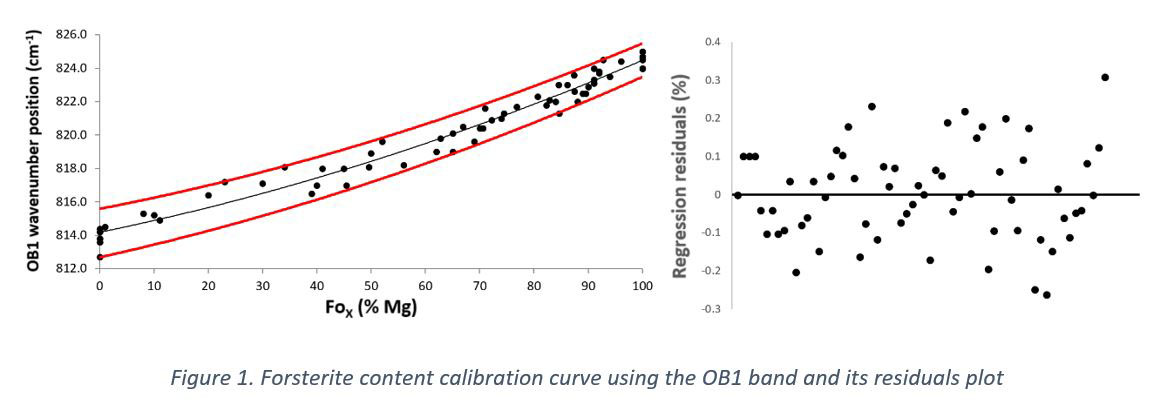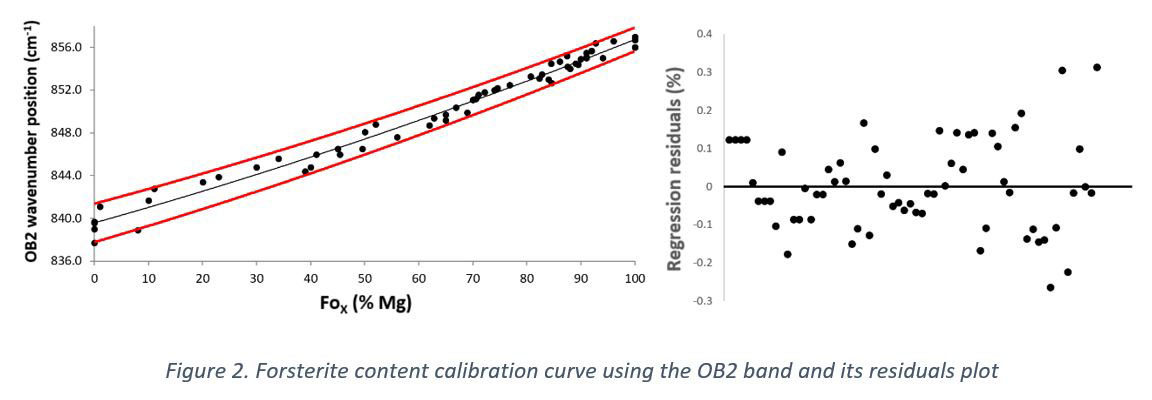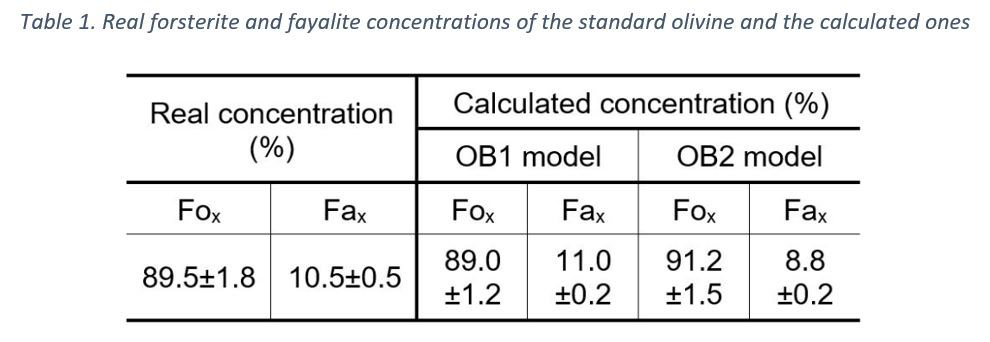Characterization of olivines and their metallic composition: Raman spectroscopy could provide an accurate solution for the active and future Mars missions
- University of the Basque Country (UPV/EHU), Faculty of Science and Technology, Department of Analytical Chemistry, Leioa, Spain (imanol.torre@ehu.eus)
1. Introduction
Olivine, (Mg, Fe)2SiO4, is a mineral composed of the two endmembers of its solid solution series: forsterite (Fo, Mg2SiO4) and fayalite (Fa, Fe2SiO4). It is a silicate mineral present in Mars usually alongside with plagioclase and pyroxene, as they are all present in basalts and igneous rocks. The forsterite and fayalite proportions in the olivine is a key factor in order to study this type of rocks.
Active and upcoming Mars missions will study areas of ancient Mars using, among others, Raman spectroscopy in the instrumental payload, being a relevant technique for space exploration. There are several papers proposing Raman spectroscopy to quantify the ratio Fo/Fa based on the wavenumbers of the two most intense bands. However, the proposed calibration models have an uncertainty of around 10 %, too high to obtain reliable conclusions form the studied samples. In this work a new model that greatly improves the accuracy and uncertainty is presented.
2. Data set
A collection of Raman spectra from olivines with a known composition was collected to develop a calibration model for the determination of the metallic content (Mg, Fe) of the mineral. The collection included 64 data points from 14 different research papers where different Raman instruments and acquisition parameters were used, which eliminates any possible bias that the instrumentation could introduce in the model. In addition to the set of olivines used for the calibration, a commercial pure olivine of known metallic concentration, Fo89.5±1.8Fa10.5±0.5, was used as the standard to validate the proposed models. This olivine was analyzed by WD-XRF and its mineral purity was checked by XRD. The Raman measurements were carried out with an Invia High Resolution micro-Raman spectrometer (Renishaw, UK) instrument, using a 532 nm excitation laser with a spectral resolution of 1 cm-1.
3. Results and Discussion
Two different regression curves were developed to characterize the olivine concentration ratio by Raman spectroscopy using their two main Raman features (OB1, 812-825 cm-1, and OB2, 837-857 cm-1). These regression curves with their residuals can be observed in Figure 1 and Figure 2 and their equations are shown in Equation 1 and 2, respectively. The two red lines depicted in the calibration curve plots represent the calculated confidence interval for all the data at a 95 % confidence level.
OB1 (cm-1) = 3.63·10-4·Fox2 + 0.0667·Fox + 814.2 (Equation 1)
OB2 (cm-1) = 3.00·10-4·Fox2 + 0.142·Fox + 839.6 (Equation 2)


As can be observed, all the data used to develop both models fit inside the confidence interval, which implies that there are not outliers among the set of data used. Regarding its quality parameters, the determination coefficient (r2) obtained for the quadratic regression models expressed in Equation 1 and 2 are 0.970 and 0.984, with a typical error of ±0.61 and ±0.73, respectively. The uncertainties in both residual plots scattered randomly, without showing any trend. In addition, all the points are equally distributed around the zero horizontal line and all of them are at the same range of distance from it. All of these facts implies that the proposed models for the data set used are the correct ones and that the model’s predictions should be correct on average, rather than systematically too high or too low.
In order to check the accuracy of the two models, the standard commercial olivine described above was used (Fo89.5±1.8Fa10.5±0.5). The concentrations obtained using the OB1 and OB2 models can be observed in Table 1.

As observed, the OB1 and OB2 forsterite confidence interval results overlap perfectly with the real concentration confidence interval, which means that the predicted concentrations with these two models were correct. In addition to the standard olivine, the calibration models were tested using the 64 data values that were used for their development. The wavenumber position of OB1 and OB2 were introduced in the respective regression curves and the forsterite value corresponding to each value was calculated. On average, it was observed that the OB1 model had better accuracy for the forsterite rich olivines, while the OB2 model was better for the fayalite rich olivines. Thus, as a good compromise solution, the best alternative would be to always use both models and to average their result, independently on the forsterite and fayalite concentrations of the mineral. This method was tested with the standard olivine, obtaining an uncertainty of ±2.1 % for the forsterite content and of ±2.0 % for the fayalite one. Uncertainties given with the 95 % level of confidence using expanded uncertainty (k=2).
The proposed equations have been applied in the study of several Lunar and Martian meteorites where olivine is present. In the NWA 11273 Lunar meteorite olivine ranged from Fo56Fa44 to Fo83Fa17, a little bit broader than the values summarized in the Meteoritical Bulletin. In the NWA 10628 Martin shergottite, the Raman bands only showed the presence of fayalite, in agreement with the data from the Meteoritical Bulletin, while the Martian shergottites RBT 0462 gave a short range (Fo9.1±0.1Fa90.9±0.1), NWA 1950 a broader range (Fo60Fa40 to Fo80Fa20) and the DaG 735 the most extended range (Fo53Fa47 to Fo80Fa20).
4. Conclusions
The study of olivines by the active and upcoming Mars missions could provide very relevant information about the evolution of the geology of Mars. One of the key parameters of this mineral is its metallic content, in other words, the ratio of forsterite and fayalite that compose them. In this work, a method to calculate that ratio by averaging the results of two calibration models that use the two main Raman bands of the mineral is proposed. With this method, an uncertainty of only 2 % is achieved, which is a significant improvement over the models already developed in literature, which have an uncertainty of around 10 %. With this model, it should be possible to provide an accurate olivine metallic characterization for the olivine Raman spectra that are found on Mars.
How to cite: Torre-Fdez, I., Garcia-Florentino, C., Huidobro, J., Coloma, L., Ruiz-Galende, P., Aramendia, J., Castro, K., Arana, G., and Madariaga, J. M.: Characterization of olivines and their metallic composition: Raman spectroscopy could provide an accurate solution for the active and future Mars missions, Europlanet Science Congress 2021, online, 13–24 Sep 2021, EPSC2021-586, https://doi.org/10.5194/epsc2021-586, 2021.

